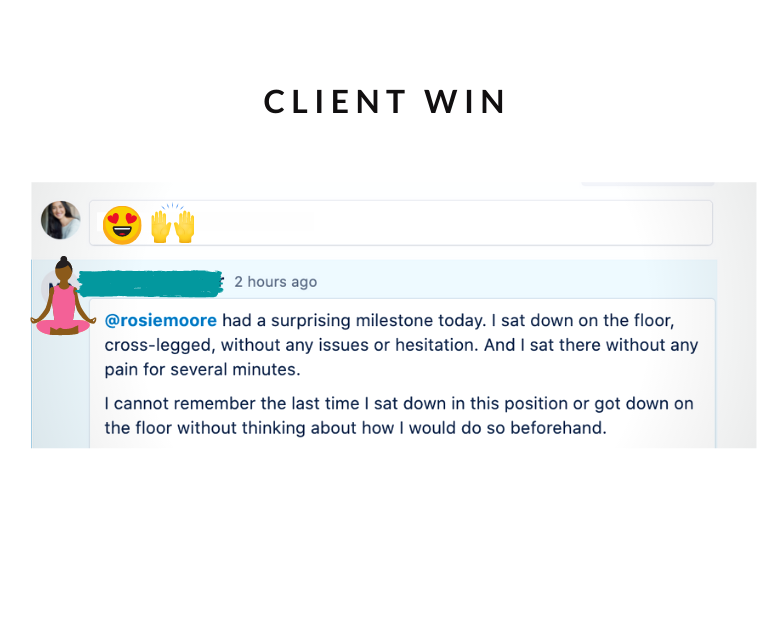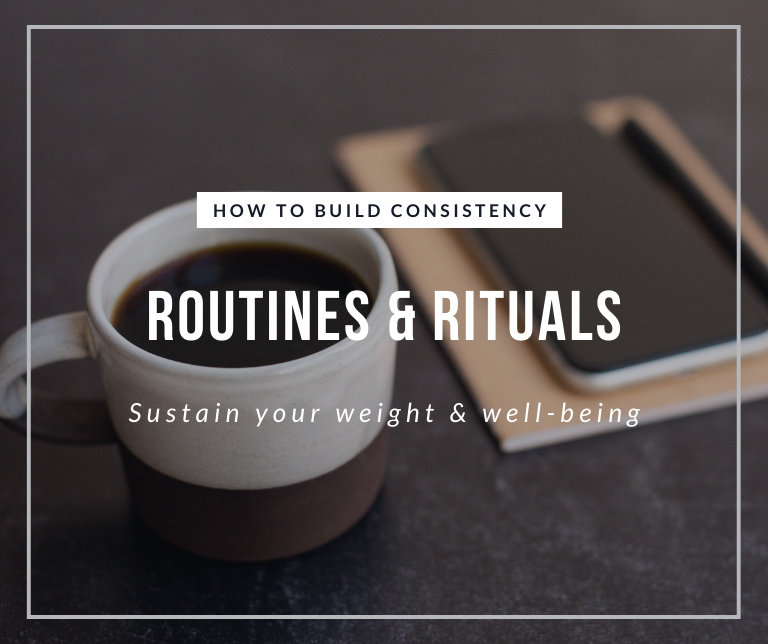One of the most important components of building a sustainable approach to your health and wellbeing is building a set of routines and rituals that shape your day and set you up to succeed.
Humans are creatures of habit, and the routines and rituals we build into our lives — when done right — create more ease, calm and joy in each day.
Your routines and rituals should align with your needs and goals, and they should empower you to truly live the life you’ve been dreaming of.
Sounds pretty good, right?
So… what ARE routines and rituals?
The ‘two Rs’ are similar, but they do have some key differences.
Routines are the things you do habitually, almost on auto-pilot. They don’t require much effort or willpower, and you don’t really have to think about them.
For many people, these are things like getting up at the same time every day, brushing your teeth in the morning, or going straight out the door for a run when you get home from work.
Rituals are things you do intentionally, with your full attention. They are moments you pause to do something mindful, or to care for yourself. They can take a little more planning and willpower, especially when you’re just establishing the ritual for yourself.
Some examples include a meditation practice, an evening walk to decompress, or journaling. You can also think of rituals as your self-care practice: the time in each day that is just for you.
Routines and Rituals That Actually Work
Because the people I work with are busy high-achievers, many of them have routines in place already. Maybe you can relate: you have a routine in place, but you feel like you’re fighting it all day, like you’re constantly behind and not quite hitting your goals.
If that’s where you’re at, it’s OK — it’s just a symptom that your routine doesn’t quite fit what you need.
See, we outgrow routines. Things change in our lives, and we don’t always take the time to update our strategies. Sometimes things change really fast, and we’re forced into a new routine without even having the option to consider whether it’s really working as well as it could.
My job is to help you identify where those routines could be optimized, and where there’s room in the day for a ritual or two.
There are 3 key components to building routines and rituals that stick, and that make you feel like you’re winning the day.
- Picking the right routines and habits for you YOU.
This is crucial, because everybody is different. You have really specific needs, and trying to squish yourself into someone else’s routine isn’t going to help you meet them.
It’s SO easy to fall into the trap of thinking you must meditate first thing in the morning because your favorite celeb did it and she also lost 30lbs.
But you’re not her, and maybe meditating first thing in the morning is a one-way ticket back to sleep for you. A break in the afternoon for your meditation might work better, or including it as part of your pre-bed routine.
It might seem like a silly thing to say, but you are 100% allowed to ditch all the stuff you think you ‘should do’ just because it’s part of someone else’s routine.
Spend some time instead thinking about YOUR life, YOUR priorities, and work backwards to figure out what’s actually a good fit for you.
- Start slow.
One of the biggest roadblocks to building routines and rituals that stick is the all-or-nothing mindset.
Trying to take on too many changes all at once can be overwhelming, and instead of becoming A Whole New You overnight, you just end up frustrated and no closer to your goals.
Recognize that change can be hard and it can be uncomfortable. Yes, it’s important to stretch yourself, but stretch just enough that it feels good — not that something breaks. Set yourself up for success by giving yourself permission to incorporate one thing at a time.
Ask yourself: What is the one thing that would make the biggest difference to your wellbeing and your sense of calm throughout the day right now? And of course, what is realistic?
- Stay mindful and be willing to reassess
The clients who have the most success after graduating from working with me are the ones that stay mindful about their situation and are willing to change their approach if circumstances change.
This is something I still have to practice myself.
For example, at the time of writing this post, my routine of getting up at 5:30am to work before my little one woke up had been going great. But then she started having trouble sleeping, which meant I was waking up a lot during the night.
I could have kept pushing for the 5:30 start, but it would have compromised the amount of rest I was getting, which I know would have a ripple effect into my work, my motivation to exercise, and into my food choices.
Instead, I decided I would get up later to protect all my other routines, and get creative about getting the work done at other times.
Stuff changes. It’s OK. The key is to be willing to adapt, and to start the practice of building up a new routine over again.
How To Build Consistency Into Your Routines and Rituals
One of the simplest ways to build consistency around a new routine or ritual is to piggyback it on something you already do every day.
What do you already do consistently every day? Identify what your habits are right now, and then tack the new habit onto one of the existing habits.
It sounds simple, and it is. Here’s an example.
One of my clients had the goal of doing a 60 min yoga class with her sister each week. But when we started, the act of sitting on the floor was extremely difficult for her.
This was a challenge because the cross-legged position was the resting position of that yoga class, so we needed to find an ‘anchor’ habit to start working on her flexibility.
I asked her to walk me through a normal day, so we could identify one habit she was consistently doing daily.
She chose brushing her teeth as her anchor habit, so we made one of her weekly goals to sit on a cushion on the ground for 2 minutes every day while she was brushing her teeth.
And after 1 month, she was able to lose the cushion and sit on the floor in the yoga class with her sister.

Many of us have a tendency to think and go BIG when it comes to our goals.
And while that ambition is great, it can sometimes set you up to fail if you don’t take the time to build a strong foundation to support that growth.
Although it doesn’t sound super exciting, I like to start small and specific to make it as easy as possible. Get some little things down and then build on them.
When you recognize that we are creatures of habit you can identify areas or habits or routines to leverage. That means you are not starting from zero — you can simply add on to what you’re already doing, and practice a little bit at a time.
Some Suggestions for Routines and Rituals:
- Morning and evening rituals & routines:
- Consistent wake-up and sleep times
- Only have 1 alarm (no snooze)
- Consistent meal times
- Pre-bed process to wind down
- A journalling/coffee/water ritual
- Movement rituals:
- Yoga to wake up or slow down
- Walk to start or end the day.
- Mindfulness meditation
- Dedicated time on specific days for specific types of exercise
- Dedicated time each week to plan meals, to shop and prep for the week ahead
- Intentionally setting aside time to eat family meals, sitting down at table, distraction free.
Routines and rituals are a powerful, liberating addition to a busy life. They help shape our days, and bring a sense of calm and order to our schedules.
When we know what’s coming next, and that we’re taking good care of ourselves, we can face each day with confidence.
We can do great work, show up for our loved ones, and really enjoy the day-to-day of our lives.
That’s an incredible gift to give yourself, and I’d love to help you make this a reality for yourself.
If you’re interested in working together through online accountability coaching, click here to learn more.

